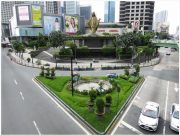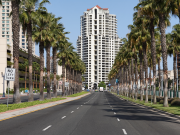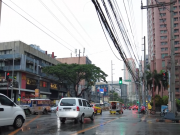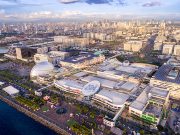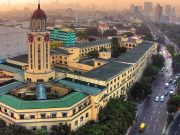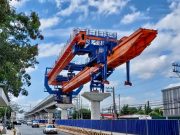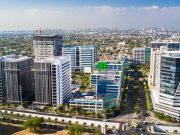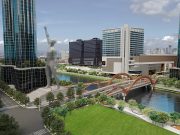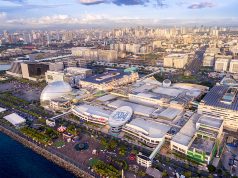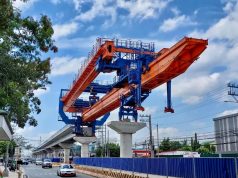Infrastructure has always been the backbone of any economy. Mobility and accessibility are powerful for industries to prosper and the Real Estate Market is no exception to this. We have a term called property appreciation, which means any property be it a house, condo, or even a commercial property such as an office building that increases in value due to its location. Metro Manila is a great example of this. There are already 8 infrastructure projects that are either in the planning stage or under construction. These developments ranging from airports to expressways and interchanges to ferries and railways will greatly impact the Real Estate landscape in the future. In this article, we’ll discuss the advantages of these projects and how they will benefit the real estate market in Metro Manila.
Fast Lanes and Faster Travel: Convenience through Interconnectivity
Major thoroughfares like Ayala Avenue, Epifanio Delos Santos Avenue (EDSA), C-5 Road and the like are the economic arteries of a developing economy. It passes through cities, business districts, residential areas, and commercial centers that provide both accessibility and convenience to residents. The most recent infrastructure projects in the Metro are the NLEX-SLEX Connector and the Taguig Integrated Terminal Exchange. A link between expressways and a 57-hectare transportation hub in South Manila will not just help daily commuters and motorists but also boost the country as a whole.
NLEX-SLEX Connector
The NLEX-SLEX Connector Road is a significant infrastructure project that spans approximately 8 kilometers. It’s a four-lane elevated expressway over the Philippine National Railway (PNR) right-of-way, starting from Caloocan Interchange, C3 Road/5th Avenue, Caloocan City to Polytechnic University of the Philippines (PUP), Sta. Mesa, Manila.
This connector road has been designed to provide a faster and more efficient means for vehicles to travel between NLEX and SLEX. It will significantly reduce travel time from NLEX to SLEX from two hours to just 20 minutes. This is expected to result in less congestion on major thoroughfares, providing a smoother and more convenient driving experience for motorists and stimulating the economies of the cities and the municipalities of neighboring areas such as Manila, Caloocan, Malabon, Navotas, and many more.
The project is not only expected to benefit motorists but also contribute to the economic growth of Metro Manila and nearby provinces. By improving access and reducing travel time, it can stimulate trade and commerce, create jobs, and boost tourism. Residents can easily travel to another city or province with such ease. The projects can also provide an alternative way for trucks and help decongest the Metro as a whole.
Taguig Integrated Terminal Exchange
The Taguig Integrated Terminal Exchange (TITX) is a transportation terminal backed by Arca South Integrated Terminal Incorporated (ASITI). Even though the terminal is still in the planning stage, the development will surely have an impact being positioned between 2 major business districts: Arca South and Bonifacio Global City (BGC) and just a few minutes away from the Ninoy Aquino International Airport (NAIA).
Strategically situated along the FTI Compound in Taguig, the 5.57-hectare transportation hub is designed to serve and connect different modes of transportation, including buses, taxis, and jeepneys. It aims to provide a more organized and efficient public transport system for commuters traveling to and from southern Luzon, Metro Manila, and nearby provinces.
The integrated terminal exchange boasts modern facilities and amenities designed to provide convenience and comfort to commuters. These include spacious waiting areas, clean restrooms, ticketing offices, information centers, and retail outlets. Moreover, it incorporates advanced security systems and traffic management technologies to ensure safe and efficient operations.
The closest mixed-use development in the Taguig Integrated Terminal Exchange is Arca South. Emerging lifestyle and business district in Taguig, the residential and commercial developments inside the township will be a worthy investment in the long run not just because of its proximity to major roads but also its distance to TITX. Everyone who resides, young professionals working in the premises, or even students can utilize a convenience to move in and out of the city. This accessibility can bring up the property prices may it be a house in a subdivision or a luxurious condo apartment that anyone can benefit from.
MAPALLA Project: A Leap Forward in Utilizing Philippine Waterways
Filipinos have always used the waterways as a means of transport. If you look closely at the position of some of the old structures like Intramuros and the recent ones one of which is the Malacañang Palace. These structures are all positioned by the sea or river. Another example of this is a trip down memory lane, one time there was an event in the Malacañang Palace it was a presidential ball and the house of its guests was just beside a waterway and called service of a “taxi” a boatman and that gentleman asked him to go to Hotel de Oriente. This scene in the film Quezon’s Game reflects the cultural significance of waterways in daily life.
These instances in the past earned Manila the title “Venice of the Orient” due to its interconnected and pristine waterways. Fast forward to the present, and while some of these watercourses have been filled up or forgotten, there are still a few that exist today and are now being modernized.
The Department of Transportation (DOTr) has plans to connect the whole Mega Manila comprising Manila Bay, Pasig River, and Laguna through a network of ferry systems. The Manila Bay-Pasig River-Laguna Lake (MAPALLA) Ferry System Project can provide commuters with an alternative mode of transport without taking so much of their time.
The MAPALLA Ferry System aims to bring back this legacy, providing an alternative mode of transport that can ease the gridlock, especially in major thoroughfares in Metro Manila. It’s projected to benefit up to 10 million commuters by connecting Manila Bay and Laguna Lake through the Pasig River. Four consulting firms have submitted proposals for the project, indicating strong interest from the private sector. The project has also been relaunched, suggesting a renewed commitment to achieving its objectives.
The MAPALLA Ferry System aims to bring back this legacy, providing an alternative mode of transport that can ease the gridlock, especially in major thoroughfares in Metro Manila. It’s projected to aid up to 10 million commuters connecting Manila Bay and Laguna Lake through Pasig River. Four consulting firms have submitted proposals for the project, indicating strong interest from the private sector.
Everyone in Metro Manila, especially from the key cities of the region namely Manila, Makati, Mandaluyong, Pasig, and Taguig can benefit from the waterway transport, especially from neighboring provinces in South Luzon such as Cavite, Laguna, and Batangas. Someone who lives in the province can have easy access to Metro Manila without facing the usual traffic congestion. It would be possible to commute from Laguna to Manila, for instance, in a fraction of the time it currently takes by road. The MAPALLA Project is about reimagining transportation, promoting environmental sustainability, stimulating economic growth, and improving the overall quality of life for Filipinos. It’s a promising step towards a more sustainable and connected future for the Philippines.
Railway: The Backbone of Interconnected Philippines
Last but not least is the news everyone is talking about, the promise of the railway projects in Metro Manila. Trains have been around since the Spanish Period famous stations like the ones in Paco and Tutuban are iconic and have vital architectural heritage and historical significance. Tutuban Station is the last station from the north and Paco Station is the first one to which anyone will ride to Cavite, Laguna, Batangas, Pangasinan, Quezon, and Albay. Now, they are set to play an even bigger role in the city’s transportation landscape, thanks to several ambitious railway projects that are currently underway.
MRT-4
Let’s start with MRT-4, the Metro Rail Transit is a railway project that aims to link MRT-3 Ortigas Station in Mandaluyong to the Province of Rizal. Commuters can experience a smooth traveling from Ortigas Center to Taytay. Apart from the transportation terminals in SM Megamall, everyone who lives and works in Metro Manila can easily beat the rush hour traffic thanks to MRT-4. The railway network also approved 10 stations namely:
- EDSA
- Meralco
- Tiendesitas
- Rosario
- St. Joseph
- Cainta Junction
- San Juan
- Tikling Junction
- Manila East Road
- Taytay
The whole project is reported to be accomplished by 2025. Due to faster transport to residential and commercial hubs as well as business districts like Ortigas Center, it will have a great effect on the pricing of the properties in its vicinity including to the adjacent province. This increased demand can lead to higher property prices. The extent of this appreciation can vary based on several factors including the proximity to the stations, the grade of the transit service, and the nature of the surrounding neighborhoods.
MRT-7
The Metro Rail Transit 7 is a 23-kilometer railway network that connects North Avenue to San Jose del Monte, Bulacan. Comprising 14 stations, it is one of the most ambitious infrastructure projects in Metro Manila. Here you can just have a train ride and travel to Bulacan in just one ride.
Once operational, the MRT-7 is expected to significantly reduce travel time between North Avenue and San Jose del Monte from the current 2-3 hours to just about 34 minutes. Here is the list of stations under MRT-7:
- North Avenue
- Quezon Memorial Circle
- University Avenue
- Tandang Sora
- Don Antonio
- Batasan
- Manggahan
- Doña Carmen
- Regalado
- Mindanao
- Quirino
- Sacred Heart
- Tala
- San Jose del Monte
MRT-7 is one of the most looked forward to projects in the Metro due to its ease of traffic on Quezon Memorial Circle, North Avenue, Mindanao Avenue, and Quirino Avenue. This provides daily commuters with an alternative way of transport besides buses, jeepneys, and taxis. and FX. It is truly a huge advantage for everyone, mostly for students going to schools nearby such as Quezon City Science High School, Philippine Science High School, University of the Philippines, and Ateneo de Manila University. Young professionals who want to establish their careers have the luxury of exploring some options in Triangle Park or the Quezon City Central Business District (CBD) where prominent IT, BPO companies, and government buildings are located.
In addition to providing efficient transport services, the MRT-7 is expected to spur economic growth in the areas it serves. It can stimulate business activities, create job opportunities, and boost local tourism both in Quezon City and Bulacan. Tourist hotspots are just a few minutes away from train stations such as Ninoy Aquino Parks and Wildlife Center (NAPWC), La Mesa Eco Park, the University of the Philippines, and so much more.
In Bulacan, several hangout destinations would come to mind, one of which is the Padre Pio Mountain of Healing, a sanctuary in San Jose del Monte where guests can immerse in faith while being surrounded by green landscapes and a staggering view of the mountain view from the top of the church.
Take a picture of the figure of Padre Pio with your family and friends while savoring the mountain ranges from afar. If we are going to talk about Real Estate investments, MRT-7 can surely influence the property prices around it. According to Colliers Philippines, it is high time for business owners to take advantage of the situation to position their companies near the upcoming infrastructure projects in the country. This will increase the prices of residential properties such as homes, residential towers, and apartments. As the condition of the country normalizes post-COVID, businesses can expect more demand and higher rental values for commercial properties.
LRT-1
Since it was first established in 1984 it has already become a vital public transport that spans from Quezon City to Pasay City. Now with its latest update on Light Rail Transit backed by Japan International Coordination Agency or JICA, LRT-1 will add 11.7 more kilometers that can reach the province Province of Cavite.
The LRT-1 Cavite extension can hold 800,000 more passengers than an additional 60% of its normal load. More kilometers means there are also 8 stations to add from its original 21 stops. LRT-1’s updated route is as follows:
As of now, the construction of the LRT-1 Cavite Extension Project is reportedly 82.7 percent complete. Despite challenges and delays, the Light Rail Manila Corporation (LRMC), the operator of LRT-1, is aiming to finish the Cavite line extension project by 2027. Interestingly, real estate mogul Manny Villar Jr. has expressed interest in expanding his business empire with a plan to take charge of the LRT-1 Cavite extension. This proposed move exemplifies the immense economic and real estate potential of the properties within proximity to the railway network.
Metro Manila Subway Project
The most awaited Metro Manila Subway Project is the first of its kind in the country. Funded by the Asian Development Bank, a 33-kilometer subway project trailing from Valenzuela to Bicutan is a great feat and within reach for every Filipino by 2029. The Metro Manila Subway consists of 14 stations all of which are under major thoroughfares and premier business districts namely QC CBD, Makati Central Business District, Bonifacio Global City, and Arca South. Here is the list of stations comprised in the project:
The strategic location of the Metro Manila Subway in the National Capital Region is also a huge advantage for homeowners and property investors. It opens a huge array of potential properties from residential, commercial, and industrial areas that can be developed within the vicinity of the stations. As for business owners, they’ll have access to an abundance of opportunities waiting to be explored in this highly synergistic environment, further encouraging them to invest more in the metro. The subway station not only will help reduce traffic congestion, but employees can easily travel to the workplace.
Some of the stops in the subway are passing through new routes like Pasig CBD, Kalayaan Avenue in Makati, BGC, FTI, and the Ninoy Aquino International Airport (NAIA). By this time there are 2 train stations in the airport as well as Tandang Sora, Quezon Avenue, Anonas, Katipunan, and NAIA. Are you planning a domestic or international flight? You can now access it by LRT-1 or using the subway. The upcoming railway projects surely bring out excitement for everyone. Interconnectivity is just a few moments away from home.
An increased presence of transport terminals can surely up the price of the land properties. Based on a recent study, land banking close to the subway can present a huge upside ROI. For instance, a condominium in Barangay San Antonio in Pasig could potentially increase in value due to its distance not just to 1 but 2 subway stations in the area.
The Metro Manila Subway is an ambitious project that everyone is waiting for. Filipinos can experience going to great lengths faster and more conveniently than ever. Interconnected train lines with MRT-3, LRT-1, and MRT-7 reflect a brighter future for pedestrians and commuters on the Metro.
Union Grand Central Station
Are you familiar with the Grand Central Terminal in New York? Can you imagine having that kind of accessibility in the Metro? That dream has already become a reality, the Union Grand Central Station is already in the works right now. Situated in the middle of Trinoma and SM North EDSA, the transportation hub is meant to bring MRT-3, MRT-7, LRT-1, and Metro Manila Subway under 1 roof.
Also known as the North Triangle Common Station, commuters can just converge to North Avenue without the need to transfer. The common station has a concourse and capacity to hold 500,000 passengers daily. The properties in Quezon City and neighboring cities will experience property appreciation because of the accessibility and convenience offered by projects that provide mobility within business districts, commercial centers, and residential developments. Imagine, everyone can beat the heavy traffic on Quirino Highway by riding MRT-7 to the Common Station. To meet his friends in BGC, he will ride the fresh Metro Manila Subway to Taguig. There are dozens of benefits of having an interconnected railway all just a few walks away from the key landmarks of Metro Manila.
With the development of various railway projects, the Philippines is slowly but surely progressing in terms of infrastructure. However, these projects should not be seen solely as a stepping-stone towards progress but rather an opportunity for further economic growth and improvements in quality of life. As more people can move freely across Metro Manila with ease, they will be encouraged to invest in real estate and business opportunities, which will benefit the country in its entirety. The future of transportation is here and it is up to us to make sure that we take full advantage of this great opportunity. Let’s all get on board and be a part of this new journey. Let’s explore and discover the vast potential of living in an interconnected metropolis!




